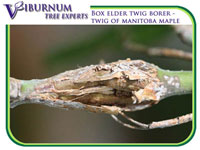Proteoteras willingan
Host
Manitoba maple
Appearance and Life Cycle

Photo credit: treeexperts.mb.ca
The adult boxelder twig borer is a small moth with a wingspan of 15-20 mm. The forewings are light brown covered with clusters and streaks of greyish and black scales. The hind wings are yellowish-tan, with a dark line along the margin. Adults are present from late June to early July, with each female producing about 100 eggs or more. The small, whitish eggs, approximately 0.5 mm long, are generally deposited singly, on the underside of the leaves. The larvae emerge from the eggs 10 to 14 days later. Throughout development the larvae have white to light reddish-brown bodies and dark brown, almost black heads. The young larvae feed in shelters constructed of webbing on the undersides of the leaves, causing a skeletonized appearance. The larvae feed on the leaves until mid-August or early September. At that time, the larvae mine dormant leaf buds and often enter twigs. The larvae form silken cocoons and overwinter in the mined cells. In the early spring, emerging larvae begin mining other buds and entering developing twigs, forming spindle-shaped swellings. During June and early July, the larvae become full grown and measure approximately 12 mm in length. The larvae drop to the ground and pupate in debris beneath the host. Moths emerge 10 to 18 days later, completing the life cycle.
Damage

frass at entrance hole.
Photo credit:James Solomon, USDA Forest Service, forestpests.org
Early larval stages strip some leaves, resulting in minimal injury. Later stages may cause excessive forking of branches, due to spindle-shaped galls which become woody, split open and die, preventing further terminal growth. The boxelder borer is not likely to kill a tree, but repeated infestations cause the tree to become bushy and undesirable as a shade tree.
Control
Control is rarely required due to natural factors such as parasites, disease and weather. However, when an outbreak does occur, control can be achieved by pruning or by applying chemicals. Pruning sucker growth in late fall and galled twigs in May and June will reduce borer populations the following year. Newly emerged larvae can be destroyed by applying dimethoate during mid-July to early August.